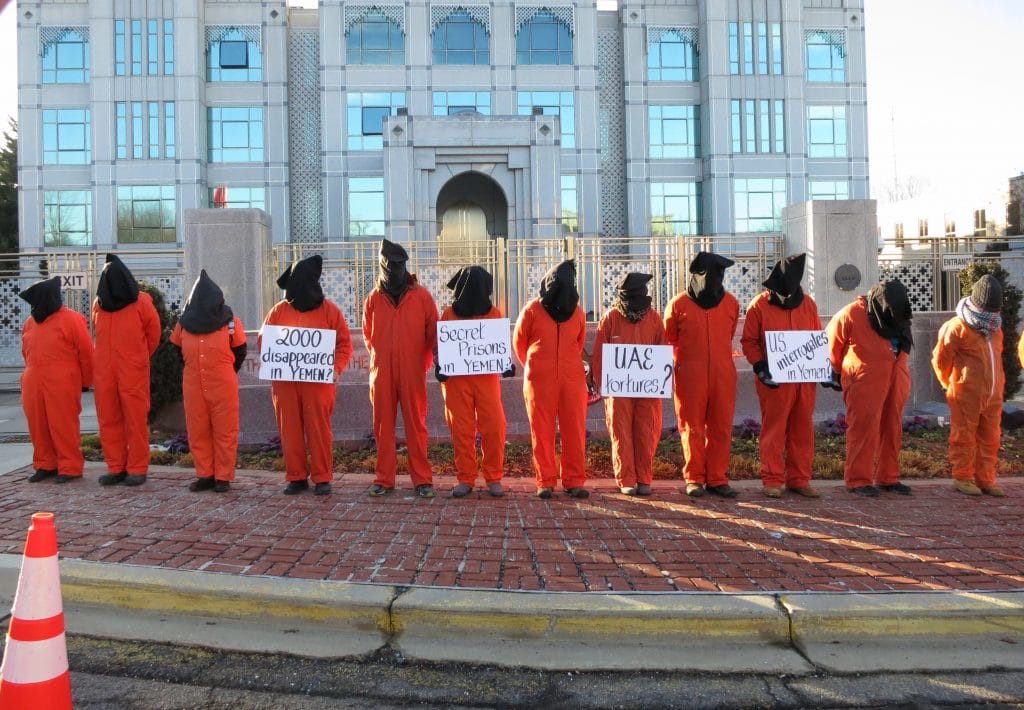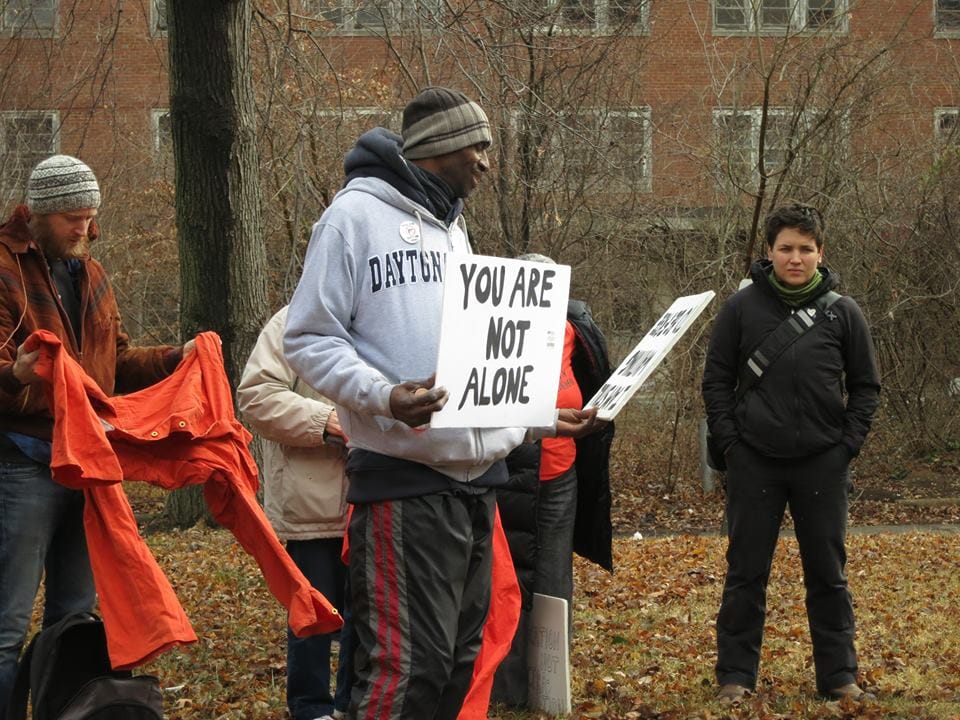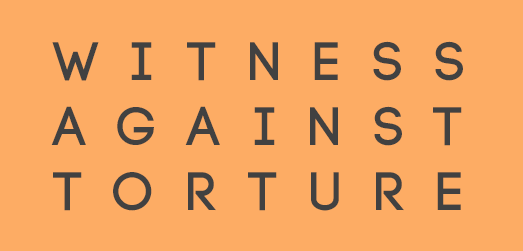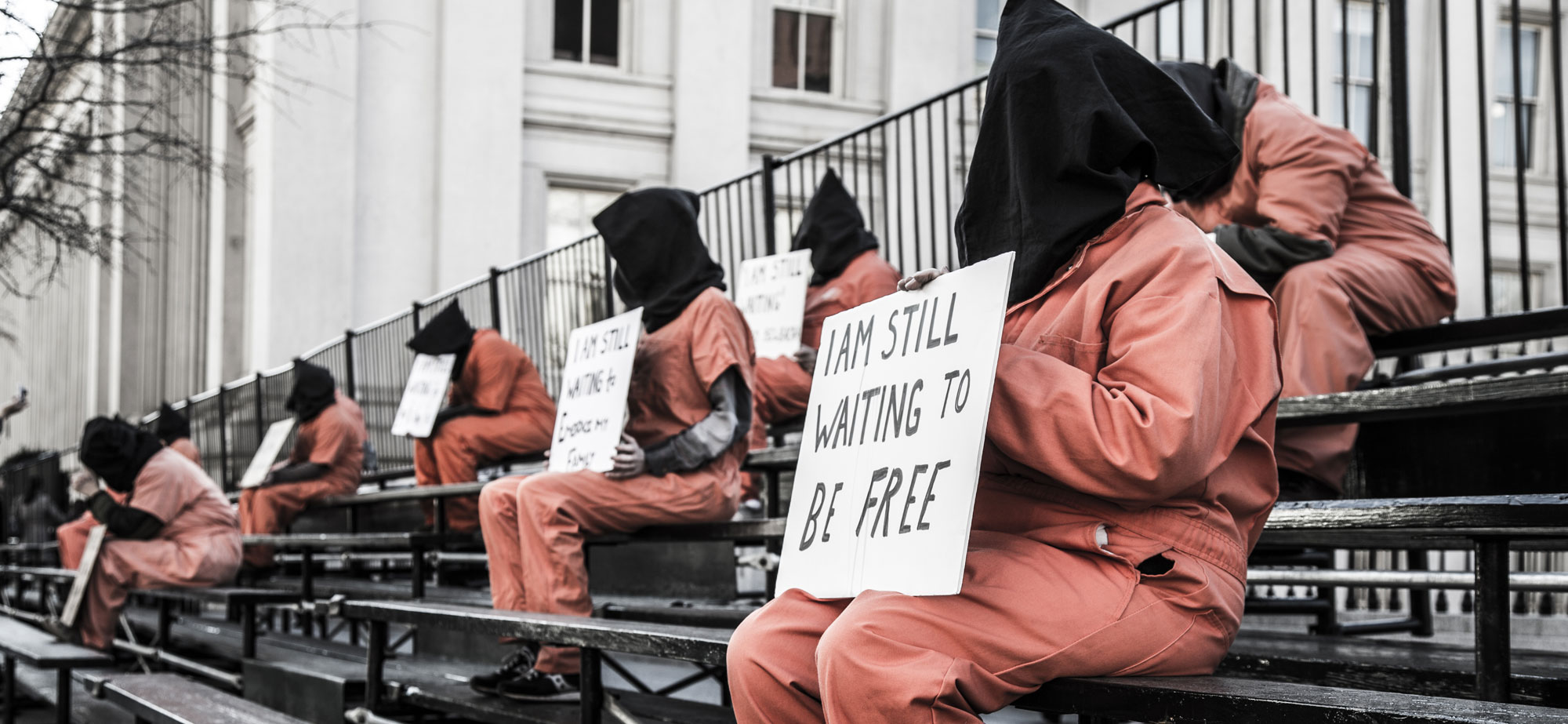From the Archive
Day 2 Update: Solidarity

Day 2 – Jan. 9, 2018
Greetings to all of you who accompany us during our Fast for Justice this week–
Monday’s work in community led to two actions expressing our solidarity with prisoners beyond the shores of Guantanamo Bay. Marc introduces us to this vision. We then share word from both those actions as well as our experience with author Marc Fallon (Unjustifiable Means) in the evening. Read on, friends…if you’re in DC, please join us for our book launch and performance tonight on the eve of the J11 rally!
Opening reflection by Marc Alvarado
Coming from a position of some privilege, I am able to spend most of my time volunteering at the InterReligious Task Force on Central America, based in Cleveland, Ohio. At IRTF, we often speak of the need to connect our regional focus (human rights violations in Central America and Colombia) to other areas of the world where these same violations take place. As such, we speak out against the atrocity at Standing Rock, while the indigenous Lenca people of Honduras have also been defending (and dying for) their sacred water sources for years. As we condemn the militarized Mexico/U.S. border, we also condemn border walls imposed on the Palestinian people. We denounce the exploitation of labor in Central America, knowing that sweatshops exist in China, Bangladesh, and Vietnam to bring cheap t-shirts and ties (I’m looking at you, Mr. President) to U.S. shores.
And as we in Witness Against Torture work to uplift the forty-one men remaining in Guantanamo, so must we call attention to clandestine prisons and torture sites in the United Arab Emirates, while also opening our hearts to victims of mass incarceration in the United States. On this second day of the Fast, we held vigil outside of the DC Jail in the morning, before demonstrating at the UAE Embassy this afternoon.
We do this because it is a beautiful and necessary thing to recognize the humanity of all people, wherever they may be, whether they be caged or free.
by Chris SpicerHankle

We sang: The walls that they build / to tear us apart/ will never be as strong as/ the walls of our heart. Soon five more appeared waving, and at another window with a quick-made Thank You sign.
The song that made my tears fall:I am not afraid/ I am not afraid/ I will live for liberation/ ‘cause I know why I was made.
The eight-story cement jail was successfully litigated for overpopulation and abuses beginning in 1971 Campbell v. McGruder. The practice of double-celling was halted in 1985 until conditions improved.A March 2016 report decries the conditions faced by women in the facility (The women average age 39 years; 90% black, 5% Hispanic, 3% white). One hour of recreation per day. No email or video visitation is available at CTF. CTF does not offer family days or any related events. D.C. women who give birth during incarceration are separated from the child immediately after birth. Of the 2723 women incarcerated at CTF 2011-2014, 245 women were pregnant. Eleven of these women gave birth while incarcerated.
As we left the facility grounds we sang. I have not/ come here alone/ my sister is locked up in a cell/ so how can we not rebel/ As long as these prisons exist/ we’re gonna be here to resist.
WAT’s Presence at the United Arab Emirates Embassy
by Kathy Kelly
“We write with great concern about reports of UAE officials maintaining clandestine prisons in Yemen,” states a letter that Witness Against Torture wrote to Yousef Al Otaiba, the United Arab Emirates Ambassador to the United States. On Day 2 of the Witness Against Torture fast, members of the group attempted to deliver the letter to Ambassador Otaiba. Security Guards declined to accept the letter, but Brian Terrell observed that while addressed to the Ambassador, it was meant for a broader audience.
Witness Against Torture wants to raise widespread public concern over reports of Yemeni prisoners being arbitrarily detained, tortured and sometimes disappeared in a network of 18 secret prisons in southern Yemen.
Already, Human Rights Watch and Amnesty International have corroborated The Associated Press report published on June 22, 2017 which charges that officials from the United Arab Emirates operate the prisons and subject detainees to gruesome torture.
Many people living in Yemen have already endured unimaginable suffering over the past three years. Saudi-led coalition bombers, supported by the U.S. regularly attack civilians with weapons sold by U.S. military contractors; residents of cities and towns risk being shelled by mortars or killed by snipers from both sides of a civil war; and, UN officials have identified one million people with cholera and warn that 8 million Yemenis face conflict-driven famine in the world’s worst humanitarian crisis.
Adding to the nightmarish conditions afflicting Yemeni people are fears of being imprisoned, tortured and possibly disappeared in a secret prison. The AP report noted that Amnesty International called for a U.N.-led investigation “into the UAE’s and other parties’ role in setting up this horrific network of torture” and into allegations the U.S. interrogated detainees or received information possibly obtained from torture. “It would be a stretch to believe the US did not know or could not have known that there was a real risk of torture,” said Amnesty’s director of research in the Middle East, Lynn Maalouf.
“We feel particularly responsible to confront the U.S. government’s involvement in torture,” the WAT letter continues. “It’s alleged that U.S. interrogators have been present in Yemen and, while not inside the chambers where people have been tortured, U.S. officials have possibly interrogated people who have been subjected to torture.”
An estimated 2000 people in Yemen have claimed that their loved ones have disappeared.
Wearing orange jumpsuits and black hoods, WAT members formed a line in front of the United Arab Emirates Embassy, bearing placards reflecting questions asked in their letter: “How specifically does the government of the United Arab Emirates respond to each of the allegations made in the June 22nd, 2017 AP report? What information can you offer regarding the presence of U.S. interrogators who acknowledge having been in Yemen to conduct interrogations? How has the UAE government responded to the families and lawyers who claim that an estimated 2000 people in Yemen have disappeared?
WAT encourages its members to help amplify Yemenis voices, as fears and grievances are raised, through education, outreach, publicity and ongoing demonstrations. Please see the following links for our press release and letter.
Press release: WAT visits UAE embassy with questions about secret prisons and torture in Yemen
WAT letter to the UAE Ambassador
We visited Kramerbooks in the evening, joining a packed room for a presentation by Mark Fallon, author of Unjustifiable Means. Chris writes a review of his experience.
Review by Chris Spicer-Hankle
Unjustifiable Means: The Inside Story of How the CIA, Pentagon, and US Government Conspired to Torture
by Mark Fallon
With aching legs I arrive at Kramerbooks two hours early. Handling the book I see that every page has fragments blacked out, a page front and back, a paragraph, a single word. Multiple direct objects are reduced to just one: the interrogation training was received at Fort Bragg and…. Interrogation training—read torture training. Compared to Mohammadu Ould Slahi’s book–held in CIA archives for ten years, censored pages notwithstanding–the effect is not as sincere. No mention of WAT partners Amnesty or CCR in the acknowledgements. A chapter named ‘Honor Bound to Defend Freedom’ makes no mention of the 2004 conscience-searing play by that name. The book closes at “this writing” with 41 detainees and an ongoing price of detention at 11 million per prisoner.
Fallon concludes war crimes were committed at GITMO and practices passed back and forth between Guantanamo and Bagram, each using the other as justification. In 2009, Karen Greenberg documented the instances of procedure copy from Guantanamo to Abu Ghraib–here it’s boiled down without citation: “Miller and his team wanted to build a ‘miniature Guantanamo Bay’ at Abu Ghraib prison” (146). Greenberg’s work The Least Worst Place: Guantanamo’s First One Hundred Days gave an account of prisoners organizing non-cooperation which escalated to hunger strikes, depicting General Lehnert sitting face to face on the ground with detainees in resolution. While Fallon had visited the Guantanamo prison as a consultant he offers a thin description. Detainees had grounds to rebel. After compelling accounts by Moazzam Begg and Mohammadu Ould Slahi, Mark Fallon’s lacks dramatic narrative, the feel of language. His “Inside story” is decidedly uninterested in human interest, as far as the detainees are concerned. I look up longingly at a new Don Dellilo book, shake my head at the copacetic How to Survive during Trump, and am almost dizzy at the competition for a book that flies in the face of Trump’s belief “torture works…we should go much stronger than waterboarding.”
Thus, preparing to meet the author with gratitude and a few searching questions, I plunk down the overpriced $27.11. After an hour I am acquainted with the gradient transition of Guantanamo in 2002 under the care of General Lehnert, the control of General Dunlavy and then the honor of General Miller. “By the summer of 2002” said Fallon at Kramerbooks, “the damage had been done.” I’m left with the sad fact Fallon acts much like the retired intelligence agent of the 1970s seeking to turn experience into value.
Today’s work (Wednesday) will include an afternoon grieving procession and ritual as well as our evening book launch at Impact Hub. Learn more about our book here.
Deep gratitude for your solidarity, friends.
The WAT community
***If you’d like to receive daily updates from this week’s Fast for Justice, please send an e-mail with “fast updates” in the subject to witnesstorture@gmail.com.
Witness Against Torture on Social Media:
Please “like” us on Facebook & follow us on Twitter.
Post any pictures of your local activities to our Flickr group.
Donate
Please consider a donation to help fund our annual Fast for Justice this January. We are completely volunteer driven and run. We have no paid staff; all of the money you donate goes to funding the work we do together. We are fiscally sponsored by the Washington Peace Center. The Washington Peace Center is a verified US-registered non profit. If you are able, click here to donate.



Join us on social media